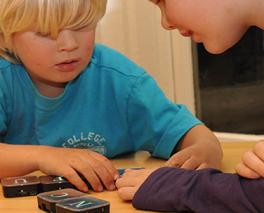
What if computers were more like a child’s wooden blocks? Siftables are a new approach to computing developed by David Merrill and Jeevan Kalanthi. Each small square electronic tile has a small screen, motion sensors, and RF signals. The siftables interact with each other, letting you use orientation, proximity, and movement to control their performance. Developed over the last few years, Merrill demonstrated siftables at TED 2009, showing how they could bring kinetic learning and physical intuition to the human-computer interface. Earlier this year Merrill and Kalanthi launched a new company, Sifteo, to bring siftables to the market. Could these blocks represent the next paradigm in the way humans use computers? Check out videos of them in action, and some new press, after the break.
When we last discussed siftables (more than a year ago) it was in the context of many different competing human-computer interfaces (HCIs). Unsurprisingly, that race is still ongoing and each project bears much in common with its competitors. Most of these systems are tactile, most let you pick up and move 3D objects, and all of them try to make interacting with a computer more intuitive. There’s no way for me to forecast whether or not siftables will ultimately be successful in the market, but there are some things that I really like about them, and that set them apart from other HCIs. First, there’s the “neat” factor. Check out this early demo of how the tiles can be used to improvise musical composition:
I also like that siftables form their own self-contained system. Many other next generation HCIs revolve around touchscreens, and use 3D objects to augment that interface. Siftables are on their own. Sure, data has to be uploaded from another source (via a port on each tile) at some point, but the actual computing experience only relies on the tiles themselves. Instead of interacting with a base screen, siftables interact with each other and with you. That means that you are free arrange them in almost any configuration – which is a much more open and dynamic concept:
The final thing that I like about siftables is that they seem perfectly geared towards education. Granted, many new HCIs are working the “kids will love this” angle. Siftables, however, already look like children’s toys. They are basically computerized building blocks. I can see any 4-6 year old picking these tiles up and easily finding ways to have fun with them (while secretly learning). Here are two education-like games that Merrill unveiled for the siftables at TED:
I am of the opinion that the future of computing (maybe even of technology in general) is going to be about specialization. It’s not just about building the world’s next great tablet computer, it’s about building the tablet computer that doctors will love, or maybe even the tablet computer custom made for Dr. Smith in Trenton, New Jersey. So too for HCIs. I don’t think we’re going to see one winner here. Instead, we may see winners for each possible demographic. Siftables really fits the early-education kinetic/tactile learning market. I know that sounds like I’m pigeon-holing them into one application, but if you look at the early work, it seems clear that this is a demographic that they could really excel in. I’d like to see Sifteo really explore that area.

Of course, there are still some unanswered questions about siftables that could affect how they are applied. I’ve yet to hear who will be able to develop programs for the system, or how those programs are synched across multiple tiles. And I’d like to know more about how big the cluster can get and still interact smoothly (a dozen tiles, one hundred?). In fact, I’m a little frustrated that Sifteo hasn’t really released any new footage of their product in the last year (most of the demos above are essentially from spring 2009 or earlier).
I probably should give them some time. Sifteo is still growing and getting things ready for the first commercialization of siftables. So it may not be clear yet what final form siftables will take or in which direciton they are looking to grow the company. There are signs that they are expanding: their site has been advertising job opportunities for a variety of specialties (software, game design, web developer, etc), and their funding seems sound (with big chunks coming from trueventures and the National Science Foundation). Merrill and Kalanthi have also been making the usual rounds at conferences this year to drum up interest. They were at the Stanford Cool Product Expo, as well as SXSW. Here’s a brief clip of them in Austin, skip to 0:50 to catch a quick peak at the latest siftable prototype:
The next generation of human computer interfaces is still in its infancy. Sifteo is a very promising startup, but who knows what kind of adult company it will grow into. The same could be said for the rest of the HCI technology we’ve seen. It may be that one of these ideas will become the dominant form of computing in the years ahead. Or it may be, as I’ve said, that each will find a niche and exploit it. Either way, we’re looking at a future where a good portion of our computing doesn’t happen with a keyboard or mouse. Given the current popularity of touchscreen tablet computers and phones, that future may already be creeping up on us.
[image credit: Sifteo]
[source: Sifteo, David Merrill page at the MIT Media Lab]


